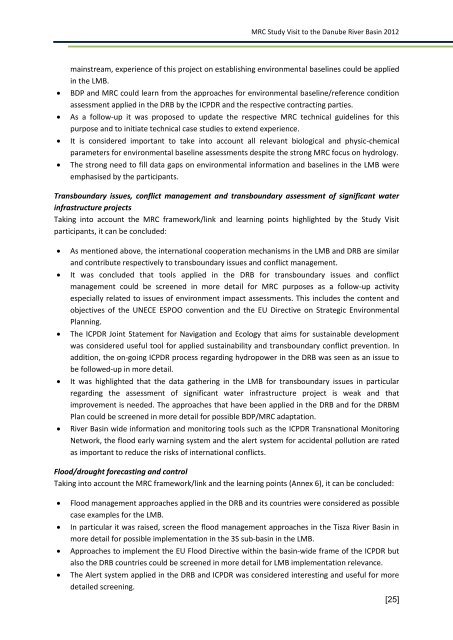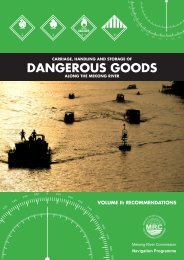evaluation of the study visit - Mekong River Commission
evaluation of the study visit - Mekong River Commission
evaluation of the study visit - Mekong River Commission
You also want an ePaper? Increase the reach of your titles
YUMPU automatically turns print PDFs into web optimized ePapers that Google loves.
MRC Study Visit to <strong>the</strong> Danube <strong>River</strong> Basin 2012<br />
mainstream, experience <strong>of</strong> this project on establishing environmental baselines could be applied<br />
in <strong>the</strong> LMB.<br />
� BDP and MRC could learn from <strong>the</strong> approaches for environmental baseline/reference condition<br />
assessment applied in <strong>the</strong> DRB by <strong>the</strong> ICPDR and <strong>the</strong> respective contracting parties.<br />
� As a follow-up it was proposed to update <strong>the</strong> respective MRC technical guidelines for this<br />
purpose and to initiate technical case studies to extend experience.<br />
� It is considered important to take into account all relevant biological and physic-chemical<br />
parameters for environmental baseline assessments despite <strong>the</strong> strong MRC focus on hydrology.<br />
� The strong need to fill data gaps on environmental information and baselines in <strong>the</strong> LMB were<br />
emphasised by <strong>the</strong> participants.<br />
Transboundary issues, conflict management and transboundary assessment <strong>of</strong> significant water<br />
infrastructure projects<br />
Taking into account <strong>the</strong> MRC framework/link and learning points highlighted by <strong>the</strong> Study Visit<br />
participants, it can be concluded:<br />
� As mentioned above, <strong>the</strong> international cooperation mechanisms in <strong>the</strong> LMB and DRB are similar<br />
and contribute respectively to transboundary issues and conflict management.<br />
� It was concluded that tools applied in <strong>the</strong> DRB for transboundary issues and conflict<br />
management could be screened in more detail for MRC purposes as a follow-up activity<br />
especially related to issues <strong>of</strong> environment impact assessments. This includes <strong>the</strong> content and<br />
objectives <strong>of</strong> <strong>the</strong> UNECE ESPOO convention and <strong>the</strong> EU Directive on Strategic Environmental<br />
Planning.<br />
� The ICPDR Joint Statement for Navigation and Ecology that aims for sustainable development<br />
was considered useful tool for applied sustainability and transboundary conflict prevention. In<br />
addition, <strong>the</strong> on-going ICPDR process regarding hydropower in <strong>the</strong> DRB was seen as an issue to<br />
be followed-up in more detail.<br />
� It was highlighted that <strong>the</strong> data ga<strong>the</strong>ring in <strong>the</strong> LMB for transboundary issues in particular<br />
regarding <strong>the</strong> assessment <strong>of</strong> significant water infrastructure project is weak and that<br />
improvement is needed. The approaches that have been applied in <strong>the</strong> DRB and for <strong>the</strong> DRBM<br />
Plan could be screened in more detail for possible BDP/MRC adaptation.<br />
� <strong>River</strong> Basin wide information and monitoring tools such as <strong>the</strong> ICPDR Transnational Monitoring<br />
Network, <strong>the</strong> flood early warning system and <strong>the</strong> alert system for accidental pollution are rated<br />
as important to reduce <strong>the</strong> risks <strong>of</strong> international conflicts.<br />
Flood/drought forecasting and control<br />
Taking into account <strong>the</strong> MRC framework/link and <strong>the</strong> learning points (Annex 6), it can be concluded:<br />
� Flood management approaches applied in <strong>the</strong> DRB and its countries were considered as possible<br />
case examples for <strong>the</strong> LMB.<br />
� In particular it was raised, screen <strong>the</strong> flood management approaches in <strong>the</strong> Tisza <strong>River</strong> Basin in<br />
more detail for possible implementation in <strong>the</strong> 3S sub-basin in <strong>the</strong> LMB.<br />
� Approaches to implement <strong>the</strong> EU Flood Directive within <strong>the</strong> basin-wide frame <strong>of</strong> <strong>the</strong> ICPDR but<br />
also <strong>the</strong> DRB countries could be screened in more detail for LMB implementation relevance.<br />
� The Alert system applied in <strong>the</strong> DRB and ICPDR was considered interesting and useful for more<br />
detailed screening.<br />
[25]













